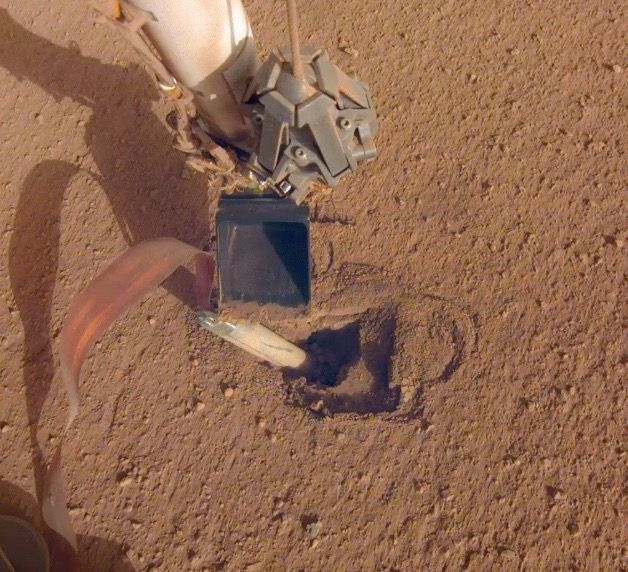
The "mole" aboard NASA's Mars InSight lander is about to get yet another push.
The mole — a self-hammering tool designed to get InSight's burrowing heat probe at least 10 feet (3 meters) underground — hasn't made much downward progress since its deployment on the Red Planet's surface in February 2019.
The Martian soil at InSight's landing site has proven to be surprisingly slippery, depriving the mole of the friction it needs to dig, mission team members have said. The team has tried several strategies to get the mole moving over the past year. The most recent effort involved pinning the mole against the side of its burrow with InSight's 5.75-foot-long (1.8 m) robotic arm, in an attempt to generate the necessary friction.
Related: Mars InSight in photos: NASA's mission to probe Martian core
Pinning met with some success initially, but the mole ended up popping back out of its hole. So, the mission team is gearing up to try using the arm in a slightly different way: pushing on the mole's top, also known as the "back cap."
This will be a somewhat delicate operation, because a fragile tether extends from the back cap to InSight's body. This tether is studded with temperature sensors, which are designed to measure the heat flowing through the Martian near-subsurface.
"It might take several tries to perfect the back-cap push, just as pinning did. Throughout late February and early March, InSight's arm will be maneuvered into position so that the team can test what happens as the mole briefly hammers," NASA officials wrote in a mission update on Friday (Feb. 21).
"Meanwhile, the team is also considering using the scoop to move more soil into the hole that has formed around the mole," they added. "This could add more pressure and friction, allowing it to finally dig down. Whether they pursue this route depends on how deep the mole is able to travel after the back-cap push."
InSight's heat probe, officially known as the Heat Flow and Physical Properties Package (HP3), was provided by the German Aerospace Center. HP3 is one of InSight's two main science instruments, the other being a suite of highly sensitive seismometers that has detected about 450 marsquakes to date.
Mission team members are also using radio signals from the lander to track the wobble of Mars' rotational axis over time, which will reveal key details about the planet's core. InSight's data will help scientists better understand Mars' interior structure, as well as the formation and evolution of rocky planets in general, mission team members have said.
The $850 million InSight spacecraft landed near the Martian equator in November 2018, kicking off a surface mission expected to last at least one Martian year (which is nearly two Earth years). On Monday (Feb. 24), the InSight team unveiled the mission's first official science results in a half-dozen papers published in the journals Nature Geoscience and Nature Communications.
These results show that Mars is a seismically active world, and that InSight is performing well despite the mole's struggles, said mission principal investigator Bruce Banerdt, who's based at NASA's Jet Propulsion Laboratory in Pasadena, California.
"I think we're well on our way to getting most, if not all, of the goals that we set for ourselves 10 years ago when we started this mission," Banerdt told reporters during a teleconference last week.
Mike Wall is the author of "Out There" (Grand Central Publishing, 2018; illustrated by Karl Tate), a book about the search for alien life. Follow him on Twitter @michaeldwall. Follow us on Twitter @Spacedotcom or Facebook.
https://news.google.com/__i/rss/rd/articles/CBMiRmh0dHBzOi8vd3d3LnNwYWNlLmNvbS9uYXNhLW1hcnMtaW5zaWdodC1tb2xlLW5ldy1kaWdnaW5nLXN0cmF0ZWd5Lmh0bWzSAUpodHRwczovL3d3dy5zcGFjZS5jb20vYW1wL25hc2EtbWFycy1pbnNpZ2h0LW1vbGUtbmV3LWRpZ2dpbmctc3RyYXRlZ3kuaHRtbA?oc=5
2020-02-25 12:12:00Z
52780628255192
Tidak ada komentar:
Posting Komentar